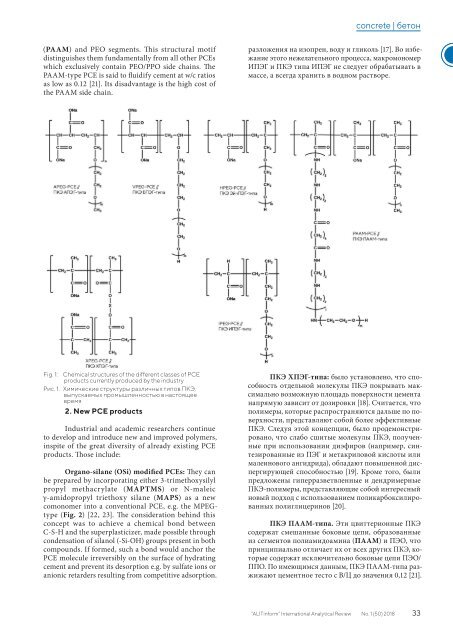AlitInform 50
“ALITinform” is a periodical that covers different aspects in production and applications of cement, concrete, and dry building mixtures. Pages of this journal offer contributions from leading Russian and International scientists, technologists and leading professionals, news from the stock markets, research laboratories, latest elaborations by producers and suppliers of modern building materials and equipment. The magazine goal is to unite on its pages the articles of the leading Russian and International specialists in the field of cement, concrete, dry building mixtures; latest news of the Russian and world building materials market, the traditions of peer-reviewed Russian scientific magazines and innovative informational approach of the contemporary printed media. The prime focus is on developments serving the purpose of rationalization of production, reduction of energy consumption, enhancement of quality and improvement of environmental safety. _______________________________________
“ALITinform” is a periodical that covers different aspects in production and applications of cement, concrete, and dry building mixtures. Pages of this journal offer contributions from leading Russian and International scientists, technologists and leading professionals, news from the stock markets, research laboratories, latest elaborations by producers and suppliers of modern building materials and equipment.
The magazine goal is to unite on its pages the articles of the leading Russian and International specialists in the field of cement, concrete, dry building mixtures; latest news of the Russian and world building materials market, the traditions of peer-reviewed Russian scientific magazines and innovative informational approach of the contemporary printed media. The prime focus is on developments serving the purpose of rationalization of production, reduction of energy consumption, enhancement of quality and improvement of environmental safety.
_______________________________________
Create successful ePaper yourself
Turn your PDF publications into a flip-book with our unique Google optimized e-Paper software.
concrete | бетон<br />
(PAAM) and PEO segments. This structural motif<br />
distinguishes them fundamentally from all other PCEs<br />
which exclusively contain PEO/PPO side chains. The<br />
PAAM-type PCE is said to fluidify cement at w/c ratios<br />
as low as 0.12 [21]. Its disadvantage is the high cost of<br />
the PAAM side chain.<br />
разложения на изопрен, воду и гликоль [17]. Во избежание<br />
этого нежелательного процесса, макромономер<br />
ИПЭГ и ПКЭ типа ИПЭГ не следует обрабатывать в<br />
массе, а всегда хранить в водном растворе.<br />
Fig. 1: Chemical structures of the different classes of PCE<br />
products currently produced by the industry<br />
Рис. 1. Химические структуры различных типов ПКЭ,<br />
выпускаемых промышленностью в настоящее<br />
время<br />
2. New PCE products<br />
Industrial and academic researchers continue<br />
to develop and introduce new and improved polymers,<br />
inspite of the great diversity of already existing PCE<br />
products. Those include:<br />
Organo-silane (OSi) modified PCEs: They can<br />
be prepared by incorporating either 3-trimethoxysilyl<br />
propyl methacrylate (MAPTMS) or N-maleic<br />
γ-amidopropyl triethoxy silane (MAPS) as a new<br />
comonomer into a conventional PCE, e.g. the MPEGtype<br />
(Fig. 2) [22, 23]. The consideration behind this<br />
concept was to achieve a chemical bond between<br />
C-S-H and the superplasticizer, made possible through<br />
condensation of silanol (-Si-OH) groups present in both<br />
compounds. If formed, such a bond would anchor the<br />
PCE molecule irreversibly on the surface of hydrating<br />
cement and prevent its desorption e.g. by sulfate ions or<br />
anionic retarders resulting from competitive adsorption.<br />
ПКЭ ХПЭГ-типа: было установлено, что способность<br />
отдельной молекулы ПКЭ покрывать максимально<br />
возможную площадь поверхности цемента<br />
напрямую зависит от дозировки [18]. Считается, что<br />
полимеры, которые распространяются дальше по поверхности,<br />
представляют собой более эффективные<br />
ПКЭ. Следуя этой концепции, было продемонстрировано,<br />
что слабо сшитые молекулы ПКЭ, полученные<br />
при использовании диэфиров (например, синтезированные<br />
из ПЭГ и метакриловой кислоты или<br />
малеинового ангидрида), обладают повышенной диспергирующей<br />
способностью [19]. Кроме того, были<br />
предложены гиперразветвленные и дендримерные<br />
ПКЭ-полимеры, представляющие собой интересный<br />
новый подход с использованием поликарбоксилированных<br />
полиглицеринов [20].<br />
ПКЭ ПААМ-типа. Эти цвиттерионные ПКЭ<br />
содержат смешанные боковые цепи, образованные<br />
из сегментов полиамидоамина (ПAAM) и ПЭО, что<br />
принципиально отличает их от всех других ПКЭ, которые<br />
содержат исключительно боковые цепи ПЭО/<br />
ППО. По имеющимся данным, ПКЭ ПААМ-типа разжижают<br />
цементное тесто с В/Ц до значения 0,12 [21].<br />
“ALITinform” International Analytical Review No. 1 (<strong>50</strong>) 2018<br />
33



